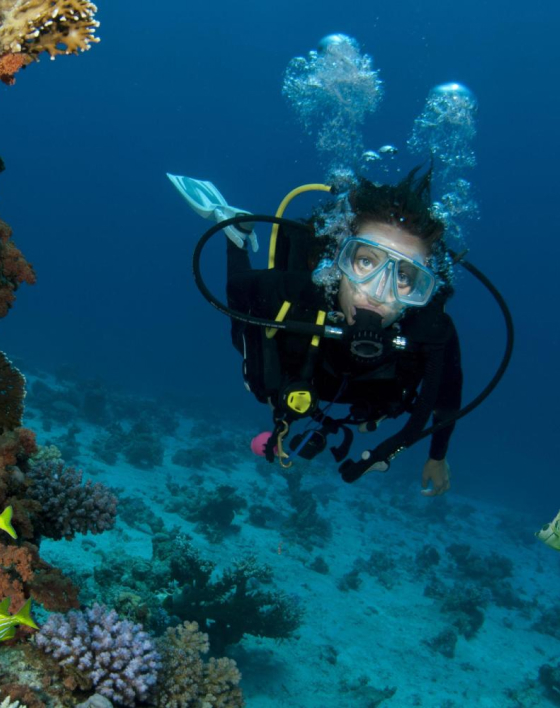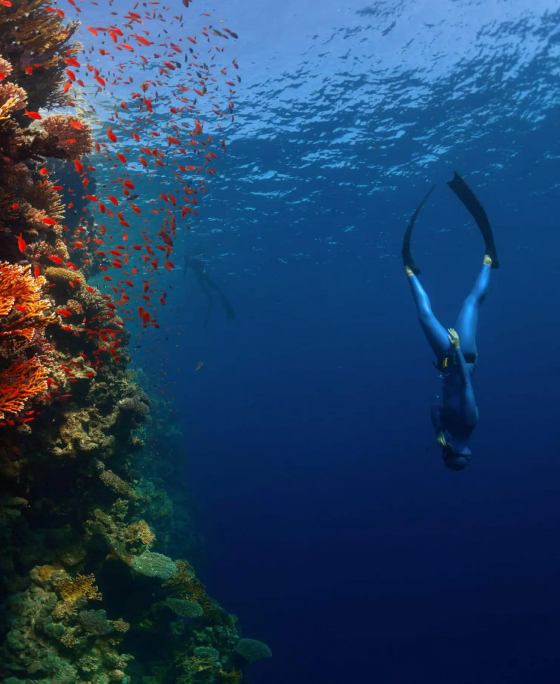Diving courses
PADI Open Water Diver
This is the entry-level certification in recreational scuba diving that allows to dive independently with a buddy, to a maximum depth of 18 meters (60 feet). The course includes: Theory and Knowledge Development online (elearning) that covers dive physics, physiology, equipment, and safety procedures; Confined Water Training on which students learn fundamental scuba skills, such as equipment assembly, underwater communication, buoyancy control, mask clearing, regulator retrieval and emergency procedures; 4 Open Water Dives conducted in the ocean aiming to practice the skills learned in confined water sessions; Exams and Certification: students take a final exam to demonstrate their understanding of diving principles.

PADI Advanced Open Water Diver
Next step is AOWD course designed to expand divers' knowledge, skills, and experience beyond the basic level attained in the Open Water Diver course. The course usually involves completing a Deep Dive, an Underwater Navigation Dive and Three Elective Adventure Dives (Night Diving, Wreck Diving, Underwater Photography, Peak Performance Buoyancy or Drift Diving). Knowledge Development: Similar to the Open Water Diver course, there's additional theory and knowledge development related to the chosen elective dives. PADI AOWD certification allows to dive to a maximum depth of 30 m (100 feet). It's a stepping stone toward becoming a more knowledgeable and skilled diver, opening up further opportunities for underwater exploration and enjoyment.

PADI Emergency First Response
It is a program focusing on providing primary and secondary care for medical emergencies. It's not specific to diving but is required as a prerequisite for Rescue Diver course. It focuses in Primary Care (CPR) teaching participants how to respond to life-threatening emergencies such as cardiac arrest, choking, and non-breathing/non-responsive individuals; Secondary Care (First Aid) that includes assessing injuries, bandaging, splinting, and dealing with non-life-threatening injuries and illnesses. Scenario Practice: participants engage in scenario-based learning, simulating emergency situations to apply the skills learned in real-life scenarios. Certification: Upon successful completion of the course, participants receive PADI Emergency First Response certification, which is valid for two years.

PADI Rescue Diver
It is a significant step in scuba diving education designed to teach divers how to handle emergency situations both in and out of the water, making them more prepared and capable of assisting other divers. Knowledge Development covers dive theory related to diving emergencies, recognizing stress in other divers and developing problem-solving skills. Rescue Skills Development involves learning various rescue techniques, including assisting tired, panicked or unresponsive divers etc. Scenarios simulate various diving emergencies, allowing divers to practice their response and problem-solving skills under the guidance of an instructor. Upon successful completion of the theory, confined water sessions, open water scenarios and final assessments, participants receive PADI Rescue Diver certification.

Diving specialities
PADI Nitrox Diver
PADI Enriched Air Diver course, commonly known as the Nitrox Diver course, teaches divers how to safely plan and conduct dives using enriched air nitrox, a breathing gas that has a higher oxygen content than standard air. Benefits of Nitrox diving include potentially longer bottom times within no-decompression limits, shorter surface intervals and reduced nitrogen exposure. This course is popular with divers who want to take longer dives and experience less fatigue after the dive. The course includes theory that covers gas analysis, dive planning with enriched air etc. and practical sessions.

PADI Deep Diver
The PADI Deep Diver specialty course is designed to train divers in the planning and execution of dives to a maximum depth of 40 meters (130 feet). It's an opportunity for certified divers to safely explore deeper underwater environments. Participants learn about the physiological effects of deep diving, nitrogen narcosis and decompression sickness. They also cover dive planning, gas management, equipment considerations and emergency procedures specific to deeper dives. The course involves four deep dives under the supervision of a professional instructor.

PADI Wreck Diver
This specialty course provides divers with the skills and confidence needed to explore and navigate wrecks safely. Participants learn about different types of wrecks, wreck diving equipment, potential hazards and safety considerations specific to wreck penetration. The course involves 4 wreck dives, allowing divers to apply learned techniques in real wreck environments. Upon successful completion of the theory, knowledge assessments and practical wreck dives, participants receive PADI Wreck Diver specialty certification.

PADI Night Diver
The Night Diver specialty course is designed to teach certified divers how to safely plan and conduct dives at night. It involves 3 night dives and introduces divers to the unique challenges and rewards of diving in low-light conditions, allowing them to explore the underwater world during nighttime hours. Participants learn about night diving equipment, specialized techniques for night navigation, communication signals and safety procedures specific to diving in low-light conditions. They also cover the behavior of nocturnal marine life and how it differs from daytime encounters.








